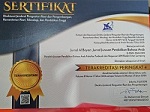Semiotic Analysis of 'Kun Fa Yakoon' Song Using Riffaterre’s Theory
Abstract
Keywords
Full Text:
PDFReferences
Aprilia, Bella Rizki Aprilia, "Repetisi dalam Cuitan Twitter Ernest Prakasa Kajian: Analisis Wacana." Wacana: Jurnal Bahasa, Seni, dan Pengajaran 7, no. 1 (2023): 19–31.
Dominikus David Biondi Situmorang, Cf. "Music as a Healing Medicine in Covid-19 Pandemic," Journal of Pastoral Care & Counseling 75, (2021).
Dwipayanti, Ni Kadek, Ayu Kris Utari Dewi Alit Mandala, and Putu Tiara Karunia Dewi. "Analisis Semiotika Riffaterre dalam Lagu Sakura Karya Naotaro Moriyama." Jurnal Pendidikan Bahasa Jepang Undiksha 7, no. 2 (2021): 139–145.
Febrianti, Fitria, Suntoko Suntoko, and Wienike Dinar Pratiwi. "Ekranisasi Novel Assalamualaikum Calon Imam Karya Madani Ke Film Assalamualaikum Calon Imam Karya Findo Purnowo Hw." Jurnal Pendidikan Tambusai 5, no. 3 (2021): 9591–9599.
Al Fikry, Mohammad Fawaid, Sunarti Mustamar, and Christanto Pudjirahardjo. "Mantra Petapa Alas Purwo: Kajian Semiotika Riffaterre." SEMIOTIKA: Jurnal Ilmu Sastra dan Linguistik 20, no. 2 (2019), 108.
G.A.Thompson, Rachel, Jerry John Nuthor, and Julene K. Johnson. "Communicating Awarness About Covid-19 Through Songs: An Example From Ghana." Journal Fronties in Public Health 8, (2021).
Hakim, Abdul. "Makna Bencana Menurut Al-Qur’an; Kajian Fenomena Terhadap Bencana di Indonesia." Hermeunetik 7, no. 2 (2013).
Hidayatullah, Muhammad Syarif."Dakwah Melalui Novel Kun Fayakun Karya Andi Bombang (Analisis Semiotika Ferdinand De Saussure)." PhD Diss., UIN FAS Bengkulu, 2021.
Huri, Ranti Maretna, Yenni Hayati, and Muhammad Ismail Nst. "Analisis Semiotika Riffaterre dalam Puisi Dongeng Marsinah Karya Sapardi Djoko Damono." Jurnal Bahasa dan Sastra 5, no. 1 (2017): 52–66.
Kulsum, Umi. "Repetisi Sebagai Penguat Ide dalam Produksi Bahasa R.A. Kartini." Metalingua 15, no. 1 (2017): 115.
Kusumawati, Aning Ayu. "Analisis Semiotik Puisi Engkau Karya Muhammad Zuhri." Widyaparwa 49, no. 2 (2021): 442–453.
Latifah, Nur, and Asep Supena. "Analisis Attention Siswa Sekolah Dasar dalam Pembelajaran Jarak Jauh di Masa Pandemi Covid-19." Jurnal Basicedu 5, no. 3 (2021): 1175–1182.
De Liska, Luh, I. Nyoman Sadwika, and I. Nyoman Astawan. "Analisis Makna Heuristik dan Hermeneutik Teks Puisi Lumpur Panas Mengebiri Tanahku Karya I Gusti Putu Bawa Samar Gantang Sebagai Penguatan Profil Pelajar Pancasila." Pedalitra: Prosiding Pedagogi, Linguistik, dan Sastra 2, no. 1 (2022): 78–84.
Mukhotob Hamzah. "Perbandingan Konsep Linguistik ‘Abd Al-Qahir Al-Jurjani dan Ferdinand de Saussure: Kajian Konseptual." Al-Ma‘Rifah 18, no. 1 (2021): 27–38.
Prasthaningrum, Ari Luh Ketut, Ni Putu Luhur Wedayanti, and Ni Luh Kade Yuliani Giri. "Metafora dalam Album Evergreen Motohiro Hata." Jurnal Humanis 17, no. 3 (2017).
Rafsanjani, Mufti Nabil, and Bermawy Munthe. "Puisi Wuqufu Al-Ma‘i Yufsiduhu Karya Al-Imam Al-Syafi’iy: Analisis Semiotik Riffaterre." `A Jamiy : Jurnal Bahasa dan Sastra Arab 11, no. 1 (2022): 68–82.
Riskayanti, Riskayanti, Juanda Juanda, and Mahmudah Mahmudah. "Heuristik dan Hermeneutik Puisi Joko Pinurbo." Jurnal Ilmiah Fonema Edukasi Bahasa dan Sastra Indonesia 6, no. 1 (2023): 74–87.
Sholikhudin, Makhfud Syawaludin M. Anang. "Bangunan Tasawwuf Falsafi Ibnu Arabi Terhadap Konsep Multikulturalisme." Journal Multicultural of Islamic Education 2, no. 1 (2018).
Sukirman, Sukirman. "Karya Sastra Media Pendidikan Karakter Bagi Peserta Didik." Jurnal Konsepsi 10, no. 1 (2021): 17–27.
Wati, Trimo, Dina Safira Ikmaliani, and Mustolehudin. "Representasi Makna Denotasi dan Konotasi dalam Lirik Lagu Kun Fayakun (Analisis Semiotika Roland Barthes)." Alibbaa’ Jurnal Pendidikan Bahasa Arab 3, no. 01 (2022).
Weny, Weny, Ngajudin Nugroho, Dewi Anggraini, Sofian Sofian, and Erwin Erwin. "Analisis Pelaksanaan Pelatihan dan Pendidikan pada PT. Bimasakti Mahawira Medan." Seminar Nasional Teknologi Komputer & Sains (Sainteks) 1, no. 1 (2019).
Zahro, Fatimatuz. "Semiotika Michael Riffaterre dalam Puisi Fî ‘Ainika Unwani Karya Faruq Juwaidah." Tsaqofiya : Jurnal Pendidikan Bahasa dan Sastra Arab 4, no. 1 (2022): 75–93.
Zaimar, Okke Kusuma Sumantri. Semiotika dalam Analisis Karya Sastra. Depok: PT. Komodo Books Anggota IKAPI, 2014.
DOI: http://dx.doi.org/10.24042/albayan.v15i2.16372
Refbacks
- There are currently no refbacks.
Copyright (c) 2023 Jurnal Al Bayan: Jurnal Jurusan Pendidikan Bahasa Arab
License URL: https://creativecommons.org/licenses/by-nc-sa/4.0
Editorial Office:
Jurnal Al Bayan: Jurnal Jurusan Pendidikan Bahasa Arab, Arabic Education Study Program, Faculty of Education and Teachers Training, Unversitas Islam Negeri Raden Intan Lampung
Jl. Endro Suratmin 1 Sukarame, Bandar Lampung 35131-Indonesia
e-mail: jurnalalbayan@radenintan.ac.id
http://ejournal.radenintan.ac.id/index.php/albayan/index
Jurnal Al Bayan: Jurnal Jurusan Pendidikan Bahasa Arab is licensed under a Creative Commons Attribution-ShareAlike 4.0 International License. p-ISSN 2086-9282 | e-ISSN 2549-1229









